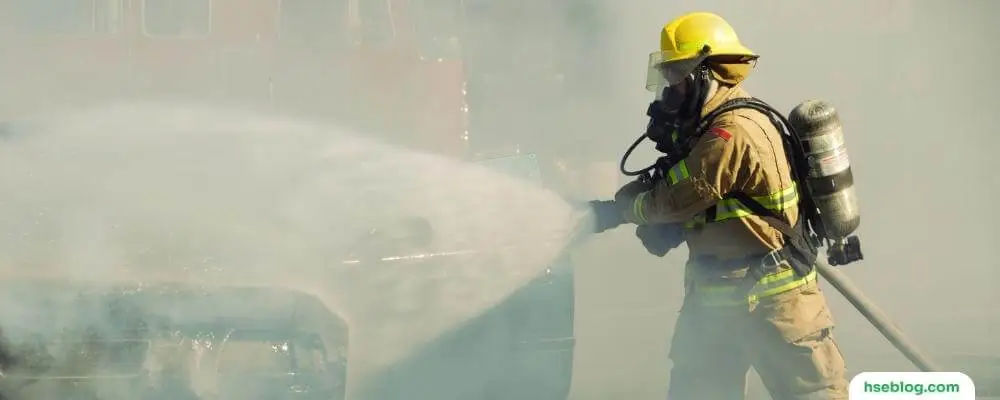Workplace fire safety is not just a matter of legal compliance; it is a matter of life and death. Ensuring that the working environment is secure from potential fire hazards is a fundamental obligation of every business owner. Key to fulfilling this responsibility is a clear understanding of the fire safety standards outlined by the Occupational Safety and Health Administration (OSHA), a federal agency responsible for enforcing safety and health legislation.
This comprehensive guide will dive deep into OSHA’s fire safety requirements, exploring their specifics, understanding their importance, and illustrating how businesses can effectively implement them. By prioritizing these measures, businesses can safeguard lives, protect property, and cultivate a culture of safety and preparedness that permeates every level of their organization. Welcome to “OSHA Fire Safety Requirements: Protecting Life and Property.”
OSHA Fire Safety Requirements
Workplace safety is a major concern for businesses of all sizes and industries. One critical aspect of ensuring a safe working environment is the prevention of fire disasters. The Occupational Safety and Health Administration (OSHA), the primary federal agency enforcing safety and health legislation, has set forth specific workplace fire safety standards.
Understanding and complying with these OSHA fire safety requirements is vital for any business to ensure their workers’ well-being and protect property.
OSHA Fire Safety requirements include:
- Adequate exit routes for evacuation during fires and other emergencies [29 CFR 1910.34)].
- Employers must provide exit routes in accordance with OSHA Standard on Exit Routes 29 CFR 1910 Subpart E, including:
- There are adequate exit routes [29 CFR 1910.36(b)].
- Exits must discharge to a safe area [29 CFR 1910.36(c)].
- Exits must be of adequate capacity and width [29 CFR 1910.36(f) and 29 CFR 1910.36(g)].
- Exits must be clearly lighted and marked [29 CFR 1910.37(b)].
- An employee alarm system is provided [29 CFR 1910.37(b)] and complies with 29 CFR 1910.165.

1. Exit Routes
Every workplace must have enough suitable exits to enable everyone to leave the facility quickly. Considerations include the following:
- Type of structure
- The number of persons exposed
- The fire protection available
- The type of industry involved
- The height and type of construction of the building or structure
In addition, fire doors must not be blocked or locked when employees are inside. However, delayed opening of fire doors is permitted when an approved alarm system is integrated into the fire door design. Exit routes from buildings must be free of obstructions and properly marked with exit signs. See 29 CFR Part 1910.36 for details about all requirements.
2. Emergency Action Plans (EAPs)
Emergency and Fire Action Plans must be provided by 29 CFR 1910.38 when required by another OSHA standard.
When required, employers must develop emergency action plans that:
- Include procedures for evacuating patients.
- Describe the routes for workers to use and procedures to follow.
- Account for all evacuated employees.
- Remain available for employee review.
- Include procedures for evacuating disabled employees.
- Address evacuation of employees who stay behind to shut down critical equipment.
- Include preferred means of alerting employees to a fire emergency.
- Provide an employee alarm system throughout the workplace.
- Require an alarm system with voice communication or sound signals such as bells, whistles, or horns.
- Make the evacuation signal known to employees.
- Ensure emergency training occurs annually.
- Require employer review of the plan with new and all employees whenever the plan is changed.
Types of Evacuation
Time frames for evacuation may differ depending on the nature of the threat and the amount of time that can be taken to prepare for moving hospital patients. Specific types of evacuations are as follows:
- Immediate: “Emergency move” – evacuate immediately, or patients and staff may die; no time to prepare.
- Rapid: Evacuate as quickly as possible; limited time to prepare (1 to 2 hours); follow procedures.
- Gradual: No immediate danger; sufficient time to evacuate (sometimes hours to several days)
- Prepare Only: Do not move patients, but you can start to prepare for evacuation.
Fire Drills
Fire drills are crucial to ensuring that all employees understand the EAP and can execute it efficiently and effectively. Regular fire drills:
- Ensure that all employees are familiar with the evacuation procedures
- Test the efficiency of the EAP
- Identify any areas of confusion or bottlenecks that may hinder an actual evacuation
- Provide an opportunity to practice, evaluate, and improve the timing and conduct of the evacuation process
While OSHA doesn’t specify how often fire drills should be held, a common best practice is to conduct them at least once a year. Some businesses or institutions (like schools or hospitals) may hold them more frequently, such as quarterly or even monthly.

3. Fire Prevention Plans (FPPs)
While the emergency action plan addresses what to do in response to a fire, fire prevention addresses what to do to prevent a fire in the first place. Here are the minimum provisions of a fire prevention plan:
- List all major fire hazards, proper handling and storage procedures for hazardous materials, potential ignition sources and their control, and the type of fire protection equipment necessary to control each major hazard. Employers should also consider protective gear such as fire-resistant clothing and metatarsal guards to safeguard employees from potential injuries caused by falling objects during fire emergencies.
- Procedures to control accumulations of flammable and combustible waste materials.
- Procedures for regular maintenance of safeguards installed on heat-producing equipment to prevent the accidental ignition of combustible materials.
- Name or job title of employees responsible for maintaining equipment to prevent or control sources of ignition or fires.
- Name or job title of employees responsible for controlling fuel source hazards. In addition, when you assign employees to a job, you must inform them of any fire hazards they may be exposed to. You must also review with each employee those parts of the fire prevention plan necessary for self-protection.
4. Portable Fire Extinguishers [29 CFR 1910.157]
The OSHA Standard requires the placement, use, maintenance, and testing of portable fire extinguishers provided for employee use. Employers need to determine whether employees should use portable fire extinguishers in the workplace and, if so, which employees will be authorized to use them. OSHA recommends training for all employees, even those who are not expected to use the equipment, to be familiar with the general principles of fire extinguisher use.
To effectively manage fire extinguishers, the following guidelines should be adhered to:
- Extinguishers should be located in conspicuous places where they are readily accessible and immediate use can be made of them.
- Extinguishers should be periodically inspected, at least annually, to assure they are maintained in a usable condition.
- Hydrostatic testing should be performed on extinguishers at the intervals specified in the regulation to ensure their effectiveness.
- Extinguishers should have a label securely attached indicating the month and year the maintenance or testing was performed and identifying the person performing the service.

5. Fire Detection Systems
In accordance with the requirements of 29 CFR 1910.164, fire detection systems must be properly installed and maintained. They must be designed and installed in such a manner that they will activate in the event of a fire before it has time to block the escape routes or exits. Some key factors to consider include:
- Systems must provide an alarm that’s distinctive and recognizable as a signal to evacuate the work area or to perform actions designated under the emergency action plan.
- After each test or alarm, fire detection systems must be restored to normal alarm service as promptly as possible.
- Manual fire alarm boxes, provided as part of the system, must be unobstructed and clearly identifiable.
- Employees must be trained to report any distinct change or abnormal response of the fire detection systems to the person or department responsible for the system.
6. Firefighter Safety
OSHA also provides specific regulations under 29 CFR 1910.156 about fire brigades’ safety and health standards (also known as industrial fire departments or fire response organizations). These requirements aim to ensure that if your workplace has a fire brigade, its members are effectively protected from harmful exposures and other hazards associated with firefighting.
Conclusion
Workplace fire safety is a paramount concern and should be prioritized in every business, regardless of the industry or size. Not only does it ensure compliance with federal laws, but more importantly, it protects employees’ lives and prevents property damage.
By adhering to OSHA’s fire safety requirements, businesses can foster a safe working environment, instill a culture of safety and preparedness, and reduce the risk of fire-related incidents and their devastating impacts. Investing in solutions like a fire extinguisher ball provides an extra layer of protection, ensuring quick response and fire suppression even when no one is present.

